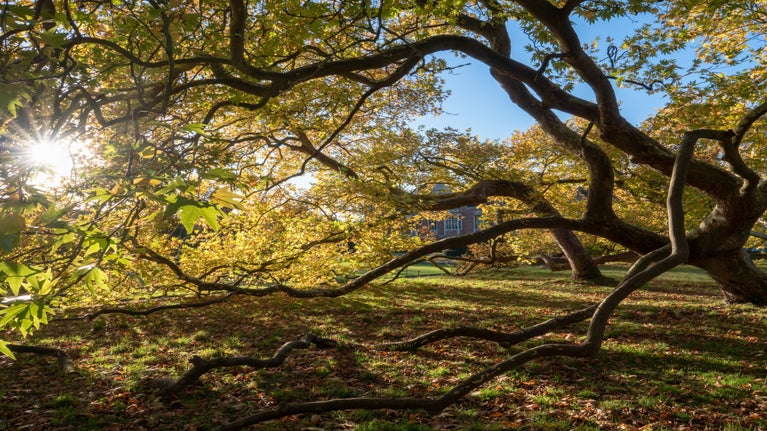
Trees and plants
We care for 25,000 hectares (61,776 acres) of woodland, 135 wild landscape sites and more than 200 gardens, and have as many wonderful stories to tell.

Holly is the UK's most familiar native evergreen and has adorned gardens and homes for centuries. Its berries are an important winter food for birds and animals, as well as being a festive season favourite, but there are a few things you may not know about the popular plant.
There are over 200 cultivated varieties of native holly, and while the Latin name, Ilex aquifolium, means with pointed leaves, not all of them are prickly. Plant collectors in the 19th century introduced other holly species from China and Japan, and the Victorians, who prized the versatile plant for its tolerance to pollution in industrial areas, raised many hybrids at nurseries.
It is these nurseries that are thought to be the source of some of the 38 different hollies identified at Tyntesfield, near Bristol. These days, some of the most unusual and notable varieties are propagated at the National Trust's Plant Conservation Centre in Devon.
Superstition, magic and myth surround holly’s deeply pagan roots. The Druids, Celts and Romans brought evergreens into their homes during winter, believing the plant’s ability to keep its leaves was magical and assured the return of spring.
In Christianity, holly was adopted as a symbol of Christ’s crown of thorns, the crimson berries a symbol of his blood and the evergreen a metaphor for life after death.

The tradition of decking the halls with boughs of holly at Christmas continues today. Gardeners and volunteers cut holly and other evergreens from National Trust places to create garlands and wreaths to decorate doors, bannisters, mantelpieces and halls.
Most hollies are either male or female and need the opposite sex nearby to produce fruit. There are many varieties of both in the holly wood in Dr Wilfrid Fox’s arboretum at Winkworth in Surrey, but two confused specimens stand out.
When naming the festive sounding silver queen and golden king, with their creamy-white and yellow-tipped leaves, the plant breeders muddled the sexes. The queen is actually a male holly and the king is female.
As one of Britain’s most common native trees, holly has been used by furniture makers for centuries. Its dense and finely-textured wood was popular in decorative marquetry and inlay work, and as the whitest wood it can also be easily stained.
It was used as an inlay in Elizabethan oak furniture and later in the 17th century to form lighter bands of colour on walnut-veneered furniture. During the second half of the 18th century, holly appeared more extensively in fashionable neo-classical furniture, either in its natural white form or stained with colours.
As well as its decorative uses, holly wood burns hot and long, making it a perfect fire fuel on cold winter nights.
Hollies play an important role in the design of many of the gardens we care for. The grand terrace in the high-Victorian garden at Tyntesfield has 10 formal flower beds, each containing a crown of holly. The broad path from the house is also lined with hollies, their tightly clipped pin-cushion heads creating a striking feature.

Created around 1700, the garden at Dyrham Park near Bath was one of the most ambitious of its day. Leading garden designer, George London, adopted the fashionable Dutch baroque style and many hollies featured among the fountains, canal, parterres and walks.
London also designed a formal garden at Hanbury Hall in Worcestershire, however it suffered the same fate as Dyrham's garden and was swept away in the following century.
When Hanbury’s early 18th-century garden was recreated in the 1990s, gilded balls were added to the variegated hollies in the parterre, echoing gold balls on the weathervane and bowling green pavilions, unifying the garden as London would have intended.

We care for 25,000 hectares (61,776 acres) of woodland, 135 wild landscape sites and more than 200 gardens, and have as many wonderful stories to tell.
Learn how to spot red squirrels, the best times to see them and how to tell them apart from grey squirrels.

Take a look at our guidelines for responsible seal spotting and top tips for seal watching.

If you’d like to see more birds in your outdoor space, discover how you can make a simple bird feeder with just a few items and ingredients.

Discover what wildlife and wildflowers you can see in meadows this summer, including butterflies, grasshoppers, moths and orchids.
